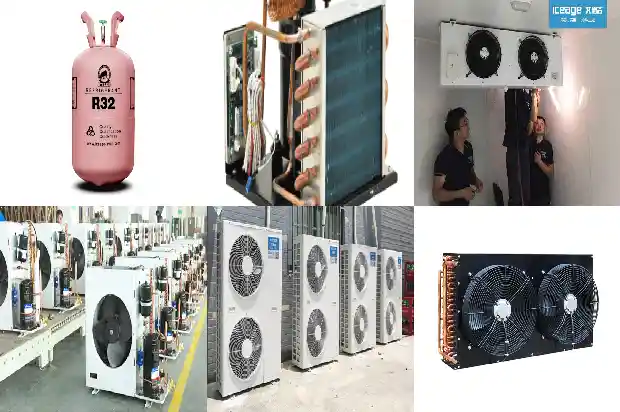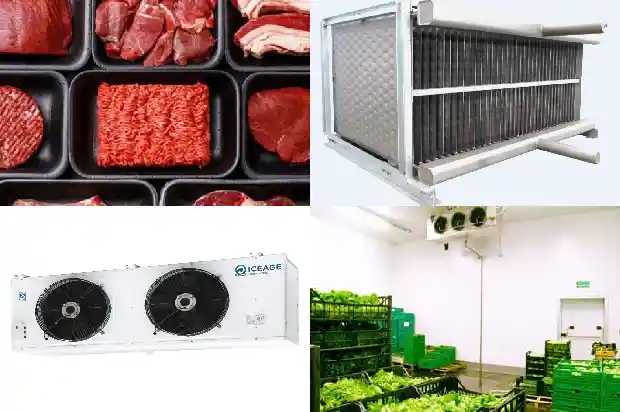Obscure Knowledge of Static Pressure, Dynamic Pressure, Latent Heat and Sensible Heat in the HVAC Industry
2024-12-20
What is a secondary refrigerant and what is its working principle?
Answer: It is a medium substance that transfers the refrigerating capacity of a refrigeration device to the cooled medium.
For example, the chilled water in common air conditioners is cooled and its temperature drops in the evaporator, and then it is transported over a long distance to cool the objects that need to be cooled. Currently, water is commonly used as a secondary refrigerant, which is only applicable in an environment above 0 °C. When the environment is below 0 °C, brine is generally used, such as an aqueous solution of sodium chloride or calcium chloride, or an aqueous solution of organic chemicals like ethylene glycol or propylene glycol.
Currently, water is used as a medium for underfloor heating and water-cooled air conditioners. If they are not used in winter, remember to drain the water in the pipes, otherwise the pipes are prone to being frozen and cracked. Especially, the maintenance cost of underfloor heating is relatively high.
Answer: It is a medium substance that transfers the refrigerating capacity of a refrigeration device to the cooled medium.
For example, the chilled water in common air conditioners is cooled and its temperature drops in the evaporator, and then it is transported over a long distance to cool the objects that need to be cooled. Currently, water is commonly used as a secondary refrigerant, which is only applicable in an environment above 0 °C. When the environment is below 0 °C, brine is generally used, such as an aqueous solution of sodium chloride or calcium chloride, or an aqueous solution of organic chemicals like ethylene glycol or propylene glycol.
Currently, water is used as a medium for underfloor heating and water-cooled air conditioners. If they are not used in winter, remember to drain the water in the pipes, otherwise the pipes are prone to being frozen and cracked. Especially, the maintenance cost of underfloor heating is relatively high.
What is sensible heat?
Sensible heat: During the process of heating or cooling an object, the heat that needs to be absorbed or released when the temperature rises or falls without changing its original phase state is called "sensible heat".
It can make people clearly feel the change in heat or cold, and it can usually be measured with a thermometer. (For example, the heat absorbed when water is heated from 20 °C to 80 °C is called sensible heat.)
Sensible heat: During the process of heating or cooling an object, the heat that needs to be absorbed or released when the temperature rises or falls without changing its original phase state is called "sensible heat".
It can make people clearly feel the change in heat or cold, and it can usually be measured with a thermometer. (For example, the heat absorbed when water is heated from 20 °C to 80 °C is called sensible heat.)
What is latent heat?
Latent heat: During the process of an object absorbing or releasing heat, its phase state changes (such as gas turning into liquid), but the temperature does not change. This kind of absorbed or released heat is called "latent heat". "Latent heat" cannot be measured with a thermometer, and the human body cannot sense it either, but it can be calculated through experiments. After saturated air absorbs a certain amount of cooling capacity (that is, releases heat), a part of the water vapor will change phase into liquid water, and at this time the temperature of the saturated air does not drop. This part of the released heat is "latent heat". For example, the heat generated by the human body of the staff in the computer room and the moisture content of the air brought in by ventilation are called latent heat.
(Total heat is equal to the sum of sensible heat and latent heat.)
Latent heat: During the process of an object absorbing or releasing heat, its phase state changes (such as gas turning into liquid), but the temperature does not change. This kind of absorbed or released heat is called "latent heat". "Latent heat" cannot be measured with a thermometer, and the human body cannot sense it either, but it can be calculated through experiments. After saturated air absorbs a certain amount of cooling capacity (that is, releases heat), a part of the water vapor will change phase into liquid water, and at this time the temperature of the saturated air does not drop. This part of the released heat is "latent heat". For example, the heat generated by the human body of the staff in the computer room and the moisture content of the air brought in by ventilation are called latent heat.
(Total heat is equal to the sum of sensible heat and latent heat.)
What do the static pressure, dynamic pressure, and total pressure of a fan refer to respectively?
The pressure exerted by a fluid perpendicular to the wall of a container is called static pressure, denoted by Pj, and the unit is millimeter water column. The static pressure greater than the surrounding atmospheric pressure is positive, and when it is less than the surrounding atmospheric pressure, the static pressure is negative.
When a fluid flows in a pipe or air duct, the pressure generated due to the velocity is called dynamic pressure or velocity head. The value of dynamic pressure is always positive, denoted by Pd, and the unit is millimeter water column.
Total pressure refers to the algebraic sum of static pressure and dynamic pressure at a certain point, that is: Py = Pd + Pj, and the unit is also millimeter water column. Usually, dynamic pressure, static pressure, and total pressure are applicable to centrifugal fans and boiler flue ducts. For example, the static pressure measuring points on the boiler flue ducts are led out from the walls of the flue ducts. Therefore, the pressure gauges for flue gas pressure on the boiler instrument panel only indicate the static pressure. Since the value of dynamic pressure in the flue ducts is relatively small, it is sufficient to measure only the static values at various points during the operation of the boiler.
The pressure exerted by a fluid perpendicular to the wall of a container is called static pressure, denoted by Pj, and the unit is millimeter water column. The static pressure greater than the surrounding atmospheric pressure is positive, and when it is less than the surrounding atmospheric pressure, the static pressure is negative.


When a fluid flows in a pipe or air duct, the pressure generated due to the velocity is called dynamic pressure or velocity head. The value of dynamic pressure is always positive, denoted by Pd, and the unit is millimeter water column.
Total pressure refers to the algebraic sum of static pressure and dynamic pressure at a certain point, that is: Py = Pd + Pj, and the unit is also millimeter water column. Usually, dynamic pressure, static pressure, and total pressure are applicable to centrifugal fans and boiler flue ducts. For example, the static pressure measuring points on the boiler flue ducts are led out from the walls of the flue ducts. Therefore, the pressure gauges for flue gas pressure on the boiler instrument panel only indicate the static pressure. Since the value of dynamic pressure in the flue ducts is relatively small, it is sufficient to measure only the static values at various points during the operation of the boiler.
What do the static pressure, dynamic pressure, and total pressure of a fan refer to respectively?
The so-called definition of static pressure is: the pressure exerted by gas on the surface of an object parallel to the air flow. In simple terms: static pressure refers to the pressure to overcome the resistance of the pipeline.
The definition of dynamic pressure is: converting the kinetic energy required in gas flow into the form of pressure. In simple terms: dynamic pressure is the pressure that drives the gas to move forward.
Total pressure = static pressure + dynamic pressure.
The so-called definition of static pressure is: the pressure exerted by gas on the surface of an object parallel to the air flow. In simple terms: static pressure refers to the pressure to overcome the resistance of the pipeline.
The definition of dynamic pressure is: converting the kinetic energy required in gas flow into the form of pressure. In simple terms: dynamic pressure is the pressure that drives the gas to move forward.

Total pressure = static pressure + dynamic pressure.
Related Articles
- Practical Knowledge on Freeze Protection of Air - conditioning Equipment
- Basic Knowledge of Valve - type Components in Refrigeration Systems (Technical Sharing)
- Basic Knowledge of Cooling Towers
- Knowledge, Installation and Maintenance of Cold Storage Systems
- Fin Spacing Design of Cooler and Several Knowledge Points of Defrosting in Cold Storage
- Winter Approaches: How to Solve the Low High - pressure Issue of Air - cooled Condensing Units?
- Common Pressure Valves and Protection Devices in Refrigeration Units
- How to Troubleshoot and Repair High - pressure Protection of Air - cooled Units?
- How to Read the High - and Low - Pressure Gauges of Refrigeration Air - conditioners?
- Air - conditioner Low - pressure Alarm? These Nine Common Causes
- Why Does the Evaporation Temperature of the Refrigeration System Drop Too Low? And Why is the Condensing Pressure Too High?
- What are the Cooling and Heating Pressures of an Air Conditioner? How to Calculate the Optimal Refrigerant Quantity?
- Common Causes and Analysis of High and Low Pressure Alarms
- Multi-split air conditioner: Nitrogen charging for welding, pressure maintaining, vacuuming and refrigerant charging
- What Causes Noise in Pressure Reducing Valves?
- Pressure Gauge in Refrigeration Equipment
- Reasons and Solutions for High and Low Condensing Pressure in Air-cooled and Water-cooled Systems
- Principle of Multiple Storages in One Unit and Evaporation Pressure Regulation Methods
